Papers by Flavio Altamura

Altamura F., Paolucci S., 2023. L’incendio delle navi di Nemi. Indagine su un cold case della Sec... more Altamura F., Paolucci S., 2023. L’incendio delle navi di Nemi. Indagine su un cold case della Seconda guerra mondiale, Passamonti Editore, Grottaferrata. ISBN 979-12-210-3106-5.
È la sera del 31 maggio 1944, quattro giorni prima della liberazione di Roma. Sulle sponde del lago di Nemi, un furioso incendio divampa all’interno del Museo delle Navi Romane, fatto costruire da Mussolini per ospitare i due immensi scafi delle navi-palazzo dell’imperatore Caligola. Il museo resta in piedi, ma tutto il resto è ridotto a un cumulo di cenere. Quei magnifici reperti, unici nel loro genere e famosi in tutto il mondo, erano riemersi solo da pochi anni dalle acque del lago, che era stato addirittura svuotato per l’eccezionale impresa di recupero. La loro perdita è tragica, di valore incalcolabile per la scienza e la civiltà umana. Per indagare sulle cause del disastro viene istituita una commissione d’inchiesta, che emette presto il suo verdetto: il rogo delle navi è da imputare a un deliberato atto vandalico dei militari tedeschi che da qualche giorno avevano piazzato una batteria di cannoni vicino al museo. Ma le cose sono andate proprio così? Nel corso degli anni saranno in molti a contestare la versione ufficiale, convinti che i veri responsabili siano stati altri: chi incolpa gli sfollati che si erano rifugiati nel museo, chi accusa i partigiani che lo avrebbero incendiato in sfregio al dittatore fascista, chi punta il dito contro dei semplici ladruncoli che volevano coprire le tracce dei loro saccheggi. Chi ha ragione? Cos’è successo veramente in quelle drammatiche ore? È quanto si sono proposti di scoprire gli autori di questo lavoro, il primo dedicato all’argomento e frutto di oltre dieci anni di ricerche. La rilettura critica delle indagini svolte dagli inquirenti, la minuziosa ricostruzione degli avvenimenti che hanno preceduto e seguito l’incendio, nonché lo smantellamento sistematico di tutte le «verità» alternative avanzate nel tempo, sono soltanto le fasi preliminari di un coinvolgente processo investigativo che si snoda attraverso l’analisi di una vasta ed eterogenea documentazione inedita. In questa vera e propria controinchiesta, le risultanze della commissione subiscono una revisione radicale, mentre al loro posto si fa strada, e prende via via sempre più corpo e solidità, una nuova dinamica dei fatti tanto insospettata quanto da sempre sotto gli occhi di tutti.
Mussi M., Méndez-Quintas E., Panera J., Altamura F., di Bianco L., Bonnefille R., Briatico G., Br... more Mussi M., Méndez-Quintas E., Panera J., Altamura F., di Bianco L., Bonnefille R., Briatico G., Brunelli E., Geraads D., Mutri G., Piarulli F., Rubio Jara S., Ruta G., Sánchez-Dehesa Galán S., Serodio Domínguez A., Melis R.T., 2022. Une vue d’ensemble sur Melka Kunture, grand complexe de sites pléistocènes dans la vallée supérieure de l’Awash (Ethiopie), in L’Anthropologie, 10299. DOI: https://doi.org/10.1016/j.anthro.2022.102999
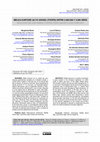
Mussi M., Méndez-Quintas E., Panera J., Altamura F., Di Bianco L., Briatico G., Mutri G., Piarull... more Mussi M., Méndez-Quintas E., Panera J., Altamura F., Di Bianco L., Briatico G., Mutri G., Piarulli F., Rubio Jara S., Ruta G., Sánchez-Dehesa Galán S., Serodio Domínguez A., Melis R.T., 2023. Melka Kunture (Alto Awash, Etiopía) entre 2.000.000 y 5.000 años, in Salduie, 23 (1), 1-11. DOI: https://doi.org/26754/ojs_salduie/sald.202318553
ABSTRACT: Melka Kunture is a cluster of prehistor-ic sites located in the Ethiopian highlands, at 2.000-2.200 m above sea level, in the Upper Awash basin. The climate is rather cool (annual mean temperature 17° C) and rainy. Palynological results prove that the original vegetation was of Afromontane type, i.e. distinct from the savanna one which develops at lower elevations. Af-ter 60 years of excavations at 20 sites and in 60 ar-chaeological levels, the sequence includes the Oldo-wan, the Acheulean, the Middle Stone Age and the Late Stone Age. Hominin fossils were discovered in direct association with the lithic technocomplexes. Ichnological levels provide information on the life and behaviour of hominins and fauna which printed their tracks. Research on the hominin adaptation to the climate and environ-ment of the highlands is relevant to understand how and when the earliest peopling of Europe happened.
Mussi M., Méndez-Quintas E., Panera J., Altamura F., Briatico G., Di Bianco L., Bonnefille R., B... more Mussi M., Méndez-Quintas E., Panera J., Altamura F., Briatico G., Di Bianco L., Bonnefille R., Brunelli E., Geraads D., Mutri G., Piarulli F., Rubio Jara S., Ruta G., Sánchez-Dehesa Galán S., Serodio Domínguez A., Melis R.T., Melka Kunture (Ethiopia) – an overview, in Book of Abstracts, Aegean Acheulean at the Eurasian crossroads. Hominin settlement in Eurasia and Africa, 25-29 June 2022, Lesbos Greece, pp. 17-18.
Altamura F., Aragie T., 2024. Reassessing Gombore I in the light of the history of research at Me... more Altamura F., Aragie T., 2024. Reassessing Gombore I in the light of the history of research at Melka Kunture (Ethiopia), in Quaternary International, 713, 109576. DOI: https://doi.org/10.1016/j.quaint.2024.10.008
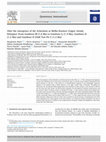
Mussi M., Altamura F., di Bianco L., Gaudzinski-Windheuser S., Geraads D., Melis R.T., Panera J.,... more Mussi M., Altamura F., di Bianco L., Gaudzinski-Windheuser S., Geraads D., Melis R.T., Panera J., Piarulli F., Pioli L., Ruta G., Sánchez Dehesa-Galán S., Méndez-Quintas E., 2021. After the emergence of the Acheulean at Melka Kunture (Upper Awash, Ethiopia): from Gombore IB (1.6Ma) to Gombore Iγ (1.4 Ma), Gombore Iδ (1.3 Ma) and Gombore II OAM Test Pit C (1.2 Ma), in Quaternary International. DOI: https://doi.org/10.1016/j.quaint.2021.02.031
Abstract: While the emergence of the Acheulean is well documented in East Africa at ~1.7 Ma, subsequent developments are less well understood and to some extent controversial. Here, we provide robust evidence regarding the time period between 1.6 Ma and 1.2 Ma, based on an interdisciplinary approach to the stratigraphic sequences exposed in the Gombore gully of Melka Kunture, in the upper Awash Valley of Ethiopia. Throughout the Pleistocene, the environment differed significantly from elsewhere in Africa because of the elevation at 2000 m asl, the cooler and rainy climate, the Afromontane vegetation, the development of endemic animal species, and the recurrent impact of volcanic activity. At Gombore IB, dated ~1.6 Ma, remains of Homo erectus/ergaster have been discovered, associated with a rich early Acheulean assemblage. The techno-typological analysis of the lithic record from Gombore Iγ (~1.4 Ma) and Gombore Iδ (~1.3 Ma), where substantial areas have been excavated, and the contrasting evidence from Gombore OAM Test Pit C (~1.2 Ma), suggest that the scarcity or lack of large flakes and large cutting tools at the two earlier sites is possibly not just the outcome of sampling bias, but rather of the adaptation of H. erectus/ergaster to the local resources, in a relatively isolated environment. The sites of Gombore gully provide new evidence on the complex pattern of human evolution and adaptation in East Africa during the Lower Pleistocene.
Briatico G., Altamura F., 2023. Combining stable isotopes and ichnological evidence: the case stu... more Briatico G., Altamura F., 2023. Combining stable isotopes and ichnological evidence: the case study of Hippopotamus cf. amphibius from Melka Kunture (Upper Awash, Ethiopia), in Origini, XLVII, pp. 7-34. ISSN 0474-6805
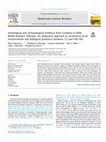
Altamura F., Bennett M.R., Marchetti L., Melis R.T., Reynolds S.C., Mussi M., 2020. Ichnological ... more Altamura F., Bennett M.R., Marchetti L., Melis R.T., Reynolds S.C., Mussi M., 2020. Ichnological and archaeological evidence from Gombore II OAM, Melka Kunture, Ethiopia: an integrated approach to reconstruct local environments and biological presences between 1.2-0.85 Ma, in Quaternary Science Reviews, 244, 106506.
Abstract: New ichnological data are available at the prehistoric site of Melka Kunture, Upper Awash Valley in Ethiopia. Excavation of new test pits enabled us to explore the volcanic and fluvio-lacustrine sequence at the Gombore II Open Air Museum archaeological site (ca. 0.85 Ma). This has allowed a detailed reconstruction of the palaeoenvironment and of the fauna present in the time interval between 1.2 and 0.85 Ma. Various-sized mammals, birds, molluscs as well as hominins left tracks throughout the sequence, and document a varied fauna and associated behaviours. Most of the hominin tracks were made by young individuals on the basis of size and are some of the earlier child tracks to be reported. The mollusc traces document the presence and orientation of water streams which, according to the associated vertebrate traces, were visited by hominins, mammals and birds. Most of these traces were found within levels traditionally considered barren for archaeology, yet they all document life activity and are always in situ. This confirms the potential of the ichnological research as an important complementary tool for archaeological investigations.
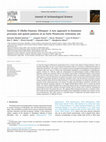
Mendez-Quintas E., Panera J., Altamura F., Di Bianco L., Melis R.T., Piarulli F., Ruta G.., Mussi... more Mendez-Quintas E., Panera J., Altamura F., Di Bianco L., Melis R.T., Piarulli F., Ruta G.., Mussi M., 2019. Gombore II (Melka Kunture, Ethiopia): a new approach to the formation processes and spatial patterns of an Early Pleistocene Acheulean site, in Journal of Archaeological Science, 108, 104975. DOI: https://doi.org/10.1016/j.jas.2019.104975
Abstract: To assess the integrity of Pleistocene archaeological sites is crucial in the analysis of human behaviour. Most of the Early Palaeolithic sites are in active fluvial environments where it is necessary to understand the degree of sedimentary disturbance. The analysis of the formation processes through geoarchaeological and geostatistical techniques offers new tools to evaluate if the archaeological assemblage is in autochthonous or allochthonous position. Gombore II, ≈850 Ka, within the archaeological and paleontological complex of Melka Kunture (Ethiopia), extends over estimated 1000 m 2 and yielded a large number of Acheulean artefacts, fossil mammal bones and two fossil hominin remains. The geomorphological setting and deposition patterns of high-energy sedimentation in a fluvial channelized environment are similar to those of many other Early Palaeolithic African sites. This is traditionally described as producing a disturbed record, with the fortuitous association of faunal remains and lithic industry driven by fluvial processes. To assess this hypothesis, we analyse here the formation processes and the spatial patterning of the remains. We apply geoarchaeological (orientation and fabric) and spatial tests (density, grouping, k-means) to the mapped archaeological surfaces and to a present-day fluvial surface. We observe substantial differences in geoarchaeological features and spatial patterning between the archaeological record (lithic materials and faunal remains) and the natural clasts of both the archaeological deposit and the bed of the present-day river. This suggests different depositional processes or temporal events. We conclude that the remains produced by the hominins did not haphazardly accumulate after extensive erosion and re-sedimentation. They rather preserve a reasonable degree of taphonomic and spatial integrity and are possibly representative of different activities.
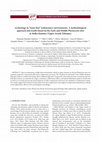
Mendez-Quintas E., Melis R.T., Altamura F., Di Bianco L., Panera J., Ruta G., Serodio Domínguez A... more Mendez-Quintas E., Melis R.T., Altamura F., Di Bianco L., Panera J., Ruta G., Serodio Domínguez A., Sánchez-Dehesa Galán S., Mussi M., 2023. Archaeology in "stone line" sedimentary environments. A methodological approach and results based on the Early and Middle Pleistocene sites at Melka Kunture (Upper Awash, Ethiopia), in Journal of Mediterranean Earth Sciences, 15, pp. 317-346. DOI: https://doi.org/10.13133/2280-6148/18153
Abstract: Sites in sedimentary cobble-bed environments, which are quite common in African Pleistocene sites, are routinely reported as extensively affected by sedimentary processes. The Gombore II and Garba I sites (Melka Kunture, Ethiopia), both in a cobble-bed setting, allow a different approach. Using archive data from previous excavations and new field observations, we analyzed size ranges, orientation, sedimentary fabrics, and spatial distribution patterns at both sites as well as in a nearby present-day stream deposit, to make comparisons and assess any similarity in sedimentary setting. The results suggest that Gombore II and Garba I have been subjected to a low degree of sedimentary disturbance, without severe taphonomic effects on the archeological assemblages.
Méndez-Quintas E., Melis R.T., Altamura F., Brunelli E., Di Bianco L., Panera J., Ruta G., Serodi... more Méndez-Quintas E., Melis R.T., Altamura F., Brunelli E., Di Bianco L., Panera J., Ruta G., Serodio Domínguez A., Sánchez-Dehesa Galán S., Mussi M., 2022. Archaeology in “stone line” sedimentary environments. A methodological approach based on the Early and Middle Pleistocene sites of Gombore II and Garba I at Melka Kunture (Upper Awash, Ethiopia)/L’archeologia dei siti di tipo “stone line”. Un approccio metodologico basato su Gombore II e Garba I, siti del Pleistocene antico e medio nella valle superiore dell’Awash a Melka Kunture (Etiopia), in Abstract Book. 40 Years of Casal de’ Pazzi – The site within the Pleistocene archaeo-palaeontological framework between 400.000 and 40.000 BP – Current knowledge and new research perspectives. Rome, Auditorium of the Ara Pacis, 30th March – 1st April 2022, pp. 14 (Eng.)/14-15 (Ita.).

Altamura F., Gaudzinski-Windheuser S., Melis R.T., Mussi M., 2019. Reassessing an early Middle Pl... more Altamura F., Gaudzinski-Windheuser S., Melis R.T., Mussi M., 2019. Reassessing an early Middle Pleistocene Hippo Butchery Site: Gombore II-2 (Melka Kunture, Upper Awash valley, Ethiopia), in Journal of Paleolithic Archaeology, 32 pp. DOI: https://doi.org/10.1007/s41982-019-00046-0
Abstract: Single-carcass sites of Lower and Middle Pleistocene age have attracted much attention since they were first recorded. They have been the focus both of science and of museum displays, with reconstructions of "hominins-feasting-on-a-carcass" purposefully illustrating a major step in human evolution. Here we report the Acheulean site Gombore II-2 in the upper Awash Valley of Ethiopia, dating to 0.7 Myr. In the 1970s, due to the presence of hippo remains, the site was published as a single-carcass butchering site. New excavations revealed an ichnosurface displaying animal and human footprints associated with bones and lithics. Subsequent studies of lithic and faunal remains of recent and past excavations as well as archive studies show that Gombore II-2 represents one of the earliest sites with hominin-hippo interaction. The hippo remains belong to a minimum of three carcasses, at least one of them butchered by hominins and subsequently ravaged by hyenas. However, instead of single carcasses exploited on the spot, evidence suggests the existence of a living floor where butchering episodes were performed through time, possibly transporting portions from scav-enging sites at a distance. Gombore II-2 thus provides unique insight into planning capacities and control over the environment probably by early representatives of Homo heidelbergensis.
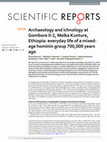
We report the occurrence at 0.7 million years (Ma) of an ichnological assemblage at Gombore II-2,... more We report the occurrence at 0.7 million years (Ma) of an ichnological assemblage at Gombore II-2, which is one of several archaeological sites at Melka Kunture in the upper Awash Valley of Ethiopia, 2000 m asl. Adults and children potentially as young as 12 months old left tracks in a silty substrate on the shore of a body of water where ungulates, as well as other mammals and birds, congregated. Furthermore, the same layers contain a rich archaeological and palaeontological record, confirming that knapping was taking place in situ and that stone tools were used for butchering hippo carcasses at the site. The site gives direct information on hominin landscape use at 0.7 Ma and may provide fresh perspective on the childhood of our ancestors. Fossil footprints provide insight into palaeoenvironments and palaeoecology and allow more detailed reconstruction of the landscapes where hominins lived. Footprints can also open a window on human behaviour and interaction with associated animals, thereby providing a snapshot of past life 1. We report on a tracksite at Gombore II-2 (Melka Kunture) in the Upper Awash Valley of Ethiopia (Fig. 1) where a trampled surface, including hominin tracks, was preserved by an ash-flow surge, dated to 0.7 Ma 2. On the basis of chronology, and in the light of homi-nin remains at Melka Kunture itself 3 , the track-maker is assumed to be Homo heidelbergensis. Tracks of mammals, ranging from small-sized gazelles to hippos and birds were also imprinted on the soft ground. The tracksite is directly associated with a rich archaeological record, including stone tools, fossil fauna and evidence of butchery. This allows us to establish an accurate reconstruction of the local environment and of hominin activities under-taken there.
Supplementary information - F. Altamura, M.R. Bennett, K. D’Août, S. Gaudzinski-Windheuser, R.T. ... more Supplementary information - F. Altamura, M.R. Bennett, K. D’Août, S. Gaudzinski-Windheuser, R.T. Melis, S.C. Reynolds, M. Mussi, 2018. Archaeology and Ichnology at Gombore II-2, Melka Kunture, Ethiopia: everyday life of a mixed-age hominin group 700,000 years ago, in Scientific reports, 8:2815 DOI:10.1038/s41598-018-21158-7.
Mussi M., Altamura F., 2019. Uno dei grandi siti dell’evoluzione umana: Melka Kunture sull’altopi... more Mussi M., Altamura F., 2019. Uno dei grandi siti dell’evoluzione umana: Melka Kunture sull’altopiano etiopico, in Immagini, ricerche e terre d’Africa, Forma Urbis, 7-8-9, pp. 16-19.
F. Altamura, M.R. Bennett, K. D’Août, S. Gaudzinski-Windheuser, R.T. Melis, S.C. Reynolds, M. Mus... more F. Altamura, M.R. Bennett, K. D’Août, S. Gaudzinski-Windheuser, R.T. Melis, S.C. Reynolds, M. Mussi, 2018. Fossil footprints in the Gombore Gully (Melka Kunture, Upper Awash, Ethiopia): A rare snapshot of Pleistocene life and environments, in PESHE 7, Proceedings of the European Society for the study of Human Evolution Vol. 7, Faro, Portugal, 13th-15th September, 2018, p. 5.
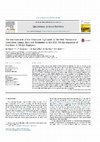
M. Mussi, F. Altamura, R. Bonnefille, D. De Rita, R.T. Melis, 2016. The environment of the Ethiop... more M. Mussi, F. Altamura, R. Bonnefille, D. De Rita, R.T. Melis, 2016. The environment of the Ethiopian highlands at the Mid Pleistocene Transition: Fauna, flora and hominins in the 850-700 ka sequence of Gombore II (Melka Kunture). Quaternary Science Reviews, 149, pp. 259-268.
Abstract: Environment, climatic change and human evolution have been debated over the last 50 years giving special attention to the Plio-Pleistocene sites of the Rift Valley. In this paper we discuss the environment and the limits of hominin adaptability based on evidence from Melka Kunture, at 2000 m asl on the Ethiopian highlands, and specifically on the ∼850 ka to ∼700 ka sequence at sub-site Gombore II. Human fossils and multiple Acheulean occurrences, as well as hippo remains and footprints, combined with palynological analysis, provide a highly detailed chronological resolution of the changing local environmental conditions during the last ∼150 ka of the MPT (Mid Pleistocene Transition), including the sequence of events after a volcanic eruption. Layers containing footprints and fossils are evidence of near-continuous occupation by hippos and their recolonization of the area after a disruptive volcanic eruption. Conversely, Acheulean implements and human fossils suggest that peopling by hominins occurred at a different and discontinuous pace even when the flora and fauna were re-established and the environment was rather stable. Most notably, the assembled evidence points to the limits of Homo erectus s.l. adaptability. Apparently, this hominin could no longer live at 2000 m asl when the climate deteriorated during glacial isotopic stage 20, becoming markedly colder than it is today, but re-colonized the area when the climate turned warmer again during isotopic stage 19
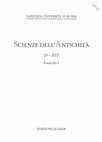
F. Altamura, M. Mussi, 2017. Archeologia e impronte fossili nel sito acheuleano di Gombore II (0,... more F. Altamura, M. Mussi, 2017. Archeologia e impronte fossili nel sito acheuleano di Gombore II (0,85 Ma), Melka Kunture, Etiopia, in Scienze dell’Antichità, 23.1, pp. 21-35. Abstract: Melka Kunture is a cluster of prehistoric sites located on the shoulder of the Main Ethiopian Rift, at 2000m asl. Tens of sites have been unearthed since the Sixties of last century, revealing a rich and persistent record, anchored to a solid absolute dating system, starting at ca. 1.8 Ma. Here we report the discovery and preliminary description of fossil footprints and trampled surfaces in the area of Gombore II, a well-known Middle Acheulean site dated at ca. 0.85 Ma. Various species of mammals produced the footprints, that went unnoticed at the time of previous research. They notably include a possible single Homo track. Footprints are considered a snapshot in time of in situ frequentation, hence they help understanding the behaviour, dynamics and association of animals and hominins. The ichnological data also allow comparisons with the
information produced by the archaeological and palaeontological record.
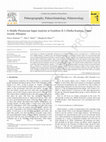
F. Altamura, M. Mussi, R.T. Melis, A Middle Pleistocene hippo tracksite at Gombore II-2 (Melka ... more F. Altamura, M. Mussi, R.T. Melis, A Middle Pleistocene hippo tracksite at Gombore II-2 (Melka Kunture, Upper Awash, Ethiopia). Palaeogeography, Palaeoclimatology, Palaeoecology, 470, 122-131. Abstract: In this paper we describe exceptionally well-preserved evidence of hippo activity at Gombore II-2, a 700,000 year-old site at Melka Kunture, at 2000 m asl in the Ethiopian highlands, in the Upper Awash Valley.
We excavated and made casts of footprints that had been left after a volcanic eruption. The 3D casts provide a detailed record of the outer anatomy and soft tissues of Pleistocene hippos. They reveal for the first time the shape of the legs and feet of the animals. Gombore II-2 also provides information on the behavior of past hippos. This prominent species of the Africanwildlife affects the vegetation and the landscape, and acts as a geomorphological agent. The animals wallow beside bodies of water and erode deep trails linking them to pastures. At
Gombore II-2 the trampling marks converge toward an erosional feature that we interpret as a fossil trail, documenting an early Middle Pleistocene behavior similar to that of today. Signs of trampling and erosional features interpreted as hippo trails have also been described in Pliocene and early Pleistocene levels at Olduvai and Koobi Fora. We further underline that the hippo population of this tract of the valley was resilient and reestablished itself not long time after the volcanic eruption.
Mussi M., Altamura F., Brunelli E., Catelli E., Cecili A., Di Bianco L., Engda B., Melis R.T., Pi... more Mussi M., Altamura F., Brunelli E., Catelli E., Cecili A., Di Bianco L., Engda B., Melis R.T., Piarulli F., Tomei N. 2017. Fossil footprints at Gombore (Melka Kunture, Upper Awash, Ethiopia): a rare snapshot of Pleistocene environments. In Conference Abstracts of the Sixth Biennal Conference of East African Association for Paleoanthropology and Paleontology (EAAPP), Addis Ababa, Ethiopia, July 30 - August 2, 2017, p. 26.
Uploads
Papers by Flavio Altamura
È la sera del 31 maggio 1944, quattro giorni prima della liberazione di Roma. Sulle sponde del lago di Nemi, un furioso incendio divampa all’interno del Museo delle Navi Romane, fatto costruire da Mussolini per ospitare i due immensi scafi delle navi-palazzo dell’imperatore Caligola. Il museo resta in piedi, ma tutto il resto è ridotto a un cumulo di cenere. Quei magnifici reperti, unici nel loro genere e famosi in tutto il mondo, erano riemersi solo da pochi anni dalle acque del lago, che era stato addirittura svuotato per l’eccezionale impresa di recupero. La loro perdita è tragica, di valore incalcolabile per la scienza e la civiltà umana. Per indagare sulle cause del disastro viene istituita una commissione d’inchiesta, che emette presto il suo verdetto: il rogo delle navi è da imputare a un deliberato atto vandalico dei militari tedeschi che da qualche giorno avevano piazzato una batteria di cannoni vicino al museo. Ma le cose sono andate proprio così? Nel corso degli anni saranno in molti a contestare la versione ufficiale, convinti che i veri responsabili siano stati altri: chi incolpa gli sfollati che si erano rifugiati nel museo, chi accusa i partigiani che lo avrebbero incendiato in sfregio al dittatore fascista, chi punta il dito contro dei semplici ladruncoli che volevano coprire le tracce dei loro saccheggi. Chi ha ragione? Cos’è successo veramente in quelle drammatiche ore? È quanto si sono proposti di scoprire gli autori di questo lavoro, il primo dedicato all’argomento e frutto di oltre dieci anni di ricerche. La rilettura critica delle indagini svolte dagli inquirenti, la minuziosa ricostruzione degli avvenimenti che hanno preceduto e seguito l’incendio, nonché lo smantellamento sistematico di tutte le «verità» alternative avanzate nel tempo, sono soltanto le fasi preliminari di un coinvolgente processo investigativo che si snoda attraverso l’analisi di una vasta ed eterogenea documentazione inedita. In questa vera e propria controinchiesta, le risultanze della commissione subiscono una revisione radicale, mentre al loro posto si fa strada, e prende via via sempre più corpo e solidità, una nuova dinamica dei fatti tanto insospettata quanto da sempre sotto gli occhi di tutti.
ABSTRACT: Melka Kunture is a cluster of prehistor-ic sites located in the Ethiopian highlands, at 2.000-2.200 m above sea level, in the Upper Awash basin. The climate is rather cool (annual mean temperature 17° C) and rainy. Palynological results prove that the original vegetation was of Afromontane type, i.e. distinct from the savanna one which develops at lower elevations. Af-ter 60 years of excavations at 20 sites and in 60 ar-chaeological levels, the sequence includes the Oldo-wan, the Acheulean, the Middle Stone Age and the Late Stone Age. Hominin fossils were discovered in direct association with the lithic technocomplexes. Ichnological levels provide information on the life and behaviour of hominins and fauna which printed their tracks. Research on the hominin adaptation to the climate and environ-ment of the highlands is relevant to understand how and when the earliest peopling of Europe happened.
Abstract: While the emergence of the Acheulean is well documented in East Africa at ~1.7 Ma, subsequent developments are less well understood and to some extent controversial. Here, we provide robust evidence regarding the time period between 1.6 Ma and 1.2 Ma, based on an interdisciplinary approach to the stratigraphic sequences exposed in the Gombore gully of Melka Kunture, in the upper Awash Valley of Ethiopia. Throughout the Pleistocene, the environment differed significantly from elsewhere in Africa because of the elevation at 2000 m asl, the cooler and rainy climate, the Afromontane vegetation, the development of endemic animal species, and the recurrent impact of volcanic activity. At Gombore IB, dated ~1.6 Ma, remains of Homo erectus/ergaster have been discovered, associated with a rich early Acheulean assemblage. The techno-typological analysis of the lithic record from Gombore Iγ (~1.4 Ma) and Gombore Iδ (~1.3 Ma), where substantial areas have been excavated, and the contrasting evidence from Gombore OAM Test Pit C (~1.2 Ma), suggest that the scarcity or lack of large flakes and large cutting tools at the two earlier sites is possibly not just the outcome of sampling bias, but rather of the adaptation of H. erectus/ergaster to the local resources, in a relatively isolated environment. The sites of Gombore gully provide new evidence on the complex pattern of human evolution and adaptation in East Africa during the Lower Pleistocene.
Abstract: New ichnological data are available at the prehistoric site of Melka Kunture, Upper Awash Valley in Ethiopia. Excavation of new test pits enabled us to explore the volcanic and fluvio-lacustrine sequence at the Gombore II Open Air Museum archaeological site (ca. 0.85 Ma). This has allowed a detailed reconstruction of the palaeoenvironment and of the fauna present in the time interval between 1.2 and 0.85 Ma. Various-sized mammals, birds, molluscs as well as hominins left tracks throughout the sequence, and document a varied fauna and associated behaviours. Most of the hominin tracks were made by young individuals on the basis of size and are some of the earlier child tracks to be reported. The mollusc traces document the presence and orientation of water streams which, according to the associated vertebrate traces, were visited by hominins, mammals and birds. Most of these traces were found within levels traditionally considered barren for archaeology, yet they all document life activity and are always in situ. This confirms the potential of the ichnological research as an important complementary tool for archaeological investigations.
Abstract: To assess the integrity of Pleistocene archaeological sites is crucial in the analysis of human behaviour. Most of the Early Palaeolithic sites are in active fluvial environments where it is necessary to understand the degree of sedimentary disturbance. The analysis of the formation processes through geoarchaeological and geostatistical techniques offers new tools to evaluate if the archaeological assemblage is in autochthonous or allochthonous position. Gombore II, ≈850 Ka, within the archaeological and paleontological complex of Melka Kunture (Ethiopia), extends over estimated 1000 m 2 and yielded a large number of Acheulean artefacts, fossil mammal bones and two fossil hominin remains. The geomorphological setting and deposition patterns of high-energy sedimentation in a fluvial channelized environment are similar to those of many other Early Palaeolithic African sites. This is traditionally described as producing a disturbed record, with the fortuitous association of faunal remains and lithic industry driven by fluvial processes. To assess this hypothesis, we analyse here the formation processes and the spatial patterning of the remains. We apply geoarchaeological (orientation and fabric) and spatial tests (density, grouping, k-means) to the mapped archaeological surfaces and to a present-day fluvial surface. We observe substantial differences in geoarchaeological features and spatial patterning between the archaeological record (lithic materials and faunal remains) and the natural clasts of both the archaeological deposit and the bed of the present-day river. This suggests different depositional processes or temporal events. We conclude that the remains produced by the hominins did not haphazardly accumulate after extensive erosion and re-sedimentation. They rather preserve a reasonable degree of taphonomic and spatial integrity and are possibly representative of different activities.
Abstract: Sites in sedimentary cobble-bed environments, which are quite common in African Pleistocene sites, are routinely reported as extensively affected by sedimentary processes. The Gombore II and Garba I sites (Melka Kunture, Ethiopia), both in a cobble-bed setting, allow a different approach. Using archive data from previous excavations and new field observations, we analyzed size ranges, orientation, sedimentary fabrics, and spatial distribution patterns at both sites as well as in a nearby present-day stream deposit, to make comparisons and assess any similarity in sedimentary setting. The results suggest that Gombore II and Garba I have been subjected to a low degree of sedimentary disturbance, without severe taphonomic effects on the archeological assemblages.
Abstract: Single-carcass sites of Lower and Middle Pleistocene age have attracted much attention since they were first recorded. They have been the focus both of science and of museum displays, with reconstructions of "hominins-feasting-on-a-carcass" purposefully illustrating a major step in human evolution. Here we report the Acheulean site Gombore II-2 in the upper Awash Valley of Ethiopia, dating to 0.7 Myr. In the 1970s, due to the presence of hippo remains, the site was published as a single-carcass butchering site. New excavations revealed an ichnosurface displaying animal and human footprints associated with bones and lithics. Subsequent studies of lithic and faunal remains of recent and past excavations as well as archive studies show that Gombore II-2 represents one of the earliest sites with hominin-hippo interaction. The hippo remains belong to a minimum of three carcasses, at least one of them butchered by hominins and subsequently ravaged by hyenas. However, instead of single carcasses exploited on the spot, evidence suggests the existence of a living floor where butchering episodes were performed through time, possibly transporting portions from scav-enging sites at a distance. Gombore II-2 thus provides unique insight into planning capacities and control over the environment probably by early representatives of Homo heidelbergensis.
Abstract: Environment, climatic change and human evolution have been debated over the last 50 years giving special attention to the Plio-Pleistocene sites of the Rift Valley. In this paper we discuss the environment and the limits of hominin adaptability based on evidence from Melka Kunture, at 2000 m asl on the Ethiopian highlands, and specifically on the ∼850 ka to ∼700 ka sequence at sub-site Gombore II. Human fossils and multiple Acheulean occurrences, as well as hippo remains and footprints, combined with palynological analysis, provide a highly detailed chronological resolution of the changing local environmental conditions during the last ∼150 ka of the MPT (Mid Pleistocene Transition), including the sequence of events after a volcanic eruption. Layers containing footprints and fossils are evidence of near-continuous occupation by hippos and their recolonization of the area after a disruptive volcanic eruption. Conversely, Acheulean implements and human fossils suggest that peopling by hominins occurred at a different and discontinuous pace even when the flora and fauna were re-established and the environment was rather stable. Most notably, the assembled evidence points to the limits of Homo erectus s.l. adaptability. Apparently, this hominin could no longer live at 2000 m asl when the climate deteriorated during glacial isotopic stage 20, becoming markedly colder than it is today, but re-colonized the area when the climate turned warmer again during isotopic stage 19
information produced by the archaeological and palaeontological record.
We excavated and made casts of footprints that had been left after a volcanic eruption. The 3D casts provide a detailed record of the outer anatomy and soft tissues of Pleistocene hippos. They reveal for the first time the shape of the legs and feet of the animals. Gombore II-2 also provides information on the behavior of past hippos. This prominent species of the Africanwildlife affects the vegetation and the landscape, and acts as a geomorphological agent. The animals wallow beside bodies of water and erode deep trails linking them to pastures. At
Gombore II-2 the trampling marks converge toward an erosional feature that we interpret as a fossil trail, documenting an early Middle Pleistocene behavior similar to that of today. Signs of trampling and erosional features interpreted as hippo trails have also been described in Pliocene and early Pleistocene levels at Olduvai and Koobi Fora. We further underline that the hippo population of this tract of the valley was resilient and reestablished itself not long time after the volcanic eruption.
È la sera del 31 maggio 1944, quattro giorni prima della liberazione di Roma. Sulle sponde del lago di Nemi, un furioso incendio divampa all’interno del Museo delle Navi Romane, fatto costruire da Mussolini per ospitare i due immensi scafi delle navi-palazzo dell’imperatore Caligola. Il museo resta in piedi, ma tutto il resto è ridotto a un cumulo di cenere. Quei magnifici reperti, unici nel loro genere e famosi in tutto il mondo, erano riemersi solo da pochi anni dalle acque del lago, che era stato addirittura svuotato per l’eccezionale impresa di recupero. La loro perdita è tragica, di valore incalcolabile per la scienza e la civiltà umana. Per indagare sulle cause del disastro viene istituita una commissione d’inchiesta, che emette presto il suo verdetto: il rogo delle navi è da imputare a un deliberato atto vandalico dei militari tedeschi che da qualche giorno avevano piazzato una batteria di cannoni vicino al museo. Ma le cose sono andate proprio così? Nel corso degli anni saranno in molti a contestare la versione ufficiale, convinti che i veri responsabili siano stati altri: chi incolpa gli sfollati che si erano rifugiati nel museo, chi accusa i partigiani che lo avrebbero incendiato in sfregio al dittatore fascista, chi punta il dito contro dei semplici ladruncoli che volevano coprire le tracce dei loro saccheggi. Chi ha ragione? Cos’è successo veramente in quelle drammatiche ore? È quanto si sono proposti di scoprire gli autori di questo lavoro, il primo dedicato all’argomento e frutto di oltre dieci anni di ricerche. La rilettura critica delle indagini svolte dagli inquirenti, la minuziosa ricostruzione degli avvenimenti che hanno preceduto e seguito l’incendio, nonché lo smantellamento sistematico di tutte le «verità» alternative avanzate nel tempo, sono soltanto le fasi preliminari di un coinvolgente processo investigativo che si snoda attraverso l’analisi di una vasta ed eterogenea documentazione inedita. In questa vera e propria controinchiesta, le risultanze della commissione subiscono una revisione radicale, mentre al loro posto si fa strada, e prende via via sempre più corpo e solidità, una nuova dinamica dei fatti tanto insospettata quanto da sempre sotto gli occhi di tutti.
ABSTRACT: Melka Kunture is a cluster of prehistor-ic sites located in the Ethiopian highlands, at 2.000-2.200 m above sea level, in the Upper Awash basin. The climate is rather cool (annual mean temperature 17° C) and rainy. Palynological results prove that the original vegetation was of Afromontane type, i.e. distinct from the savanna one which develops at lower elevations. Af-ter 60 years of excavations at 20 sites and in 60 ar-chaeological levels, the sequence includes the Oldo-wan, the Acheulean, the Middle Stone Age and the Late Stone Age. Hominin fossils were discovered in direct association with the lithic technocomplexes. Ichnological levels provide information on the life and behaviour of hominins and fauna which printed their tracks. Research on the hominin adaptation to the climate and environ-ment of the highlands is relevant to understand how and when the earliest peopling of Europe happened.
Abstract: While the emergence of the Acheulean is well documented in East Africa at ~1.7 Ma, subsequent developments are less well understood and to some extent controversial. Here, we provide robust evidence regarding the time period between 1.6 Ma and 1.2 Ma, based on an interdisciplinary approach to the stratigraphic sequences exposed in the Gombore gully of Melka Kunture, in the upper Awash Valley of Ethiopia. Throughout the Pleistocene, the environment differed significantly from elsewhere in Africa because of the elevation at 2000 m asl, the cooler and rainy climate, the Afromontane vegetation, the development of endemic animal species, and the recurrent impact of volcanic activity. At Gombore IB, dated ~1.6 Ma, remains of Homo erectus/ergaster have been discovered, associated with a rich early Acheulean assemblage. The techno-typological analysis of the lithic record from Gombore Iγ (~1.4 Ma) and Gombore Iδ (~1.3 Ma), where substantial areas have been excavated, and the contrasting evidence from Gombore OAM Test Pit C (~1.2 Ma), suggest that the scarcity or lack of large flakes and large cutting tools at the two earlier sites is possibly not just the outcome of sampling bias, but rather of the adaptation of H. erectus/ergaster to the local resources, in a relatively isolated environment. The sites of Gombore gully provide new evidence on the complex pattern of human evolution and adaptation in East Africa during the Lower Pleistocene.
Abstract: New ichnological data are available at the prehistoric site of Melka Kunture, Upper Awash Valley in Ethiopia. Excavation of new test pits enabled us to explore the volcanic and fluvio-lacustrine sequence at the Gombore II Open Air Museum archaeological site (ca. 0.85 Ma). This has allowed a detailed reconstruction of the palaeoenvironment and of the fauna present in the time interval between 1.2 and 0.85 Ma. Various-sized mammals, birds, molluscs as well as hominins left tracks throughout the sequence, and document a varied fauna and associated behaviours. Most of the hominin tracks were made by young individuals on the basis of size and are some of the earlier child tracks to be reported. The mollusc traces document the presence and orientation of water streams which, according to the associated vertebrate traces, were visited by hominins, mammals and birds. Most of these traces were found within levels traditionally considered barren for archaeology, yet they all document life activity and are always in situ. This confirms the potential of the ichnological research as an important complementary tool for archaeological investigations.
Abstract: To assess the integrity of Pleistocene archaeological sites is crucial in the analysis of human behaviour. Most of the Early Palaeolithic sites are in active fluvial environments where it is necessary to understand the degree of sedimentary disturbance. The analysis of the formation processes through geoarchaeological and geostatistical techniques offers new tools to evaluate if the archaeological assemblage is in autochthonous or allochthonous position. Gombore II, ≈850 Ka, within the archaeological and paleontological complex of Melka Kunture (Ethiopia), extends over estimated 1000 m 2 and yielded a large number of Acheulean artefacts, fossil mammal bones and two fossil hominin remains. The geomorphological setting and deposition patterns of high-energy sedimentation in a fluvial channelized environment are similar to those of many other Early Palaeolithic African sites. This is traditionally described as producing a disturbed record, with the fortuitous association of faunal remains and lithic industry driven by fluvial processes. To assess this hypothesis, we analyse here the formation processes and the spatial patterning of the remains. We apply geoarchaeological (orientation and fabric) and spatial tests (density, grouping, k-means) to the mapped archaeological surfaces and to a present-day fluvial surface. We observe substantial differences in geoarchaeological features and spatial patterning between the archaeological record (lithic materials and faunal remains) and the natural clasts of both the archaeological deposit and the bed of the present-day river. This suggests different depositional processes or temporal events. We conclude that the remains produced by the hominins did not haphazardly accumulate after extensive erosion and re-sedimentation. They rather preserve a reasonable degree of taphonomic and spatial integrity and are possibly representative of different activities.
Abstract: Sites in sedimentary cobble-bed environments, which are quite common in African Pleistocene sites, are routinely reported as extensively affected by sedimentary processes. The Gombore II and Garba I sites (Melka Kunture, Ethiopia), both in a cobble-bed setting, allow a different approach. Using archive data from previous excavations and new field observations, we analyzed size ranges, orientation, sedimentary fabrics, and spatial distribution patterns at both sites as well as in a nearby present-day stream deposit, to make comparisons and assess any similarity in sedimentary setting. The results suggest that Gombore II and Garba I have been subjected to a low degree of sedimentary disturbance, without severe taphonomic effects on the archeological assemblages.
Abstract: Single-carcass sites of Lower and Middle Pleistocene age have attracted much attention since they were first recorded. They have been the focus both of science and of museum displays, with reconstructions of "hominins-feasting-on-a-carcass" purposefully illustrating a major step in human evolution. Here we report the Acheulean site Gombore II-2 in the upper Awash Valley of Ethiopia, dating to 0.7 Myr. In the 1970s, due to the presence of hippo remains, the site was published as a single-carcass butchering site. New excavations revealed an ichnosurface displaying animal and human footprints associated with bones and lithics. Subsequent studies of lithic and faunal remains of recent and past excavations as well as archive studies show that Gombore II-2 represents one of the earliest sites with hominin-hippo interaction. The hippo remains belong to a minimum of three carcasses, at least one of them butchered by hominins and subsequently ravaged by hyenas. However, instead of single carcasses exploited on the spot, evidence suggests the existence of a living floor where butchering episodes were performed through time, possibly transporting portions from scav-enging sites at a distance. Gombore II-2 thus provides unique insight into planning capacities and control over the environment probably by early representatives of Homo heidelbergensis.
Abstract: Environment, climatic change and human evolution have been debated over the last 50 years giving special attention to the Plio-Pleistocene sites of the Rift Valley. In this paper we discuss the environment and the limits of hominin adaptability based on evidence from Melka Kunture, at 2000 m asl on the Ethiopian highlands, and specifically on the ∼850 ka to ∼700 ka sequence at sub-site Gombore II. Human fossils and multiple Acheulean occurrences, as well as hippo remains and footprints, combined with palynological analysis, provide a highly detailed chronological resolution of the changing local environmental conditions during the last ∼150 ka of the MPT (Mid Pleistocene Transition), including the sequence of events after a volcanic eruption. Layers containing footprints and fossils are evidence of near-continuous occupation by hippos and their recolonization of the area after a disruptive volcanic eruption. Conversely, Acheulean implements and human fossils suggest that peopling by hominins occurred at a different and discontinuous pace even when the flora and fauna were re-established and the environment was rather stable. Most notably, the assembled evidence points to the limits of Homo erectus s.l. adaptability. Apparently, this hominin could no longer live at 2000 m asl when the climate deteriorated during glacial isotopic stage 20, becoming markedly colder than it is today, but re-colonized the area when the climate turned warmer again during isotopic stage 19
information produced by the archaeological and palaeontological record.
We excavated and made casts of footprints that had been left after a volcanic eruption. The 3D casts provide a detailed record of the outer anatomy and soft tissues of Pleistocene hippos. They reveal for the first time the shape of the legs and feet of the animals. Gombore II-2 also provides information on the behavior of past hippos. This prominent species of the Africanwildlife affects the vegetation and the landscape, and acts as a geomorphological agent. The animals wallow beside bodies of water and erode deep trails linking them to pastures. At
Gombore II-2 the trampling marks converge toward an erosional feature that we interpret as a fossil trail, documenting an early Middle Pleistocene behavior similar to that of today. Signs of trampling and erosional features interpreted as hippo trails have also been described in Pliocene and early Pleistocene levels at Olduvai and Koobi Fora. We further underline that the hippo population of this tract of the valley was resilient and reestablished itself not long time after the volcanic eruption.